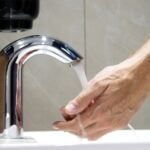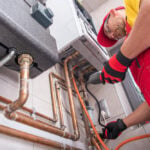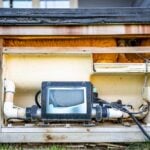
How to Tell When a Water Filter Needs Replacing
- By: Amer ZaghloulehUncategorizedComment: 0
The water filter ensures you have a clean source of water. However, this unit is prone to various malfunctions that keep it from removing contaminants. Diagnosing the breakdown promptly is key to your well-being, and this article will help you do so.
We’ll explore various dirty water filter symptoms to help you determine when you need a new filter.
How Often to Change Water Filter in House
Before we cover the signs of a water filter that needs replacing, let’s first go over a few more important points.
- How often to change water filter
- How often to change whole house filter
- How often to change well water filter
- How often to change Big Blue water filter
- How often to change water softener filter
- When to change sediment filter
Regardless of the type of your filter, the recommended replacement time depends on two factors.
- The number of gallons flowing through the system
- The length of time the filter has been operating
In general, you’ll want to replace the filter cartridge once every 6-12 months.
How to Tell When Water Filter Needs Replacing
A device that’s beyond repair leaves many signs. Here’s what you should be on the lookout for when determining if you need a well pump filter replacement or other types of replacement.
Black Mold
Black mold is a scary sight, especially in water. If you’ve noticed floaty bits after filtration, it probably means the unit can no longer be fixed.
Besides replacing the filter, you should also disinfect the nearby area to avoid health problems. Don’t forget to wear gloves and wash your hands thoroughly after handling a unit affected by black mold. Otherwise, the contamination may spread to the new model.
Foul Smell
Sulfur, chlorine, and many other substances produce overpowering smells in your potable water. They can originate from an array of sources, such as clogs. If the system is obstructed or slow, you may need to mount a new filter.
Scale Accumulation or Metallic Taste
Many homeowners never ask themselves the question, “How often should water filters be changed?” As a result, they neglect their system, which gives rise to hard water.
The most common cause of hard water is an accumulation of magnesium and calcium. These leave scaly sediment in the filter, keeping the unit from working correctly and making the fluid taste metallic. Left unchecked, it can require replacement of the device.
Slippery Water
Filtered water can sometimes feel slippery between the fingers, indicating it’s too soft. If the water from the main line is generally soft (high contents of potassium and sodium), the filter should reduce the concentration. If it isn’t, it means the filter isn’t working correctly and you need to replace it.
Slow Filtration
Water filtration isn’t fast, but it shouldn’t take forever either. Worn units can take more than six hours to fill standard-sized tanks, which isn’t rapid enough for an average household. By contrast, good filters only take around 2-3 hours. The only way to achieve this speed is to get a new filter.
High TDS
Over time, filters lose potency and can’t filter water as effectively as on their first day. One of the most reliable indicators of their condition is TDS (total dissolved soils) content. By comparing the levels of unfiltered and filtered water, you can tell how well the unit’s functioning.
For example, owners of reverse osmosis systems can use the 80% rule to determine when their filter needs replacing. If the TDS removal is at 80% or higher, you can keep your current filtration system. If the figure drops below 80%, you should probably invest in a new unit.
Reading your TDS meter is relatively straightforward. If it shows that your regular tap water has 100 ppm and filtered water has 25, it means it’s only eliminating 75% of harmful particles. As it’s under 80%, replacing the filter is your best bet.
Reduced Water Pressure
Reduced water pressure in some fixtures can be caused by many factors. The most common culprit is extensive leaking, but you should hire a plumber to verify the cause. They may determine that the pressure is low due to a clogged filter. Depending on the severity of the buildup, installing a new filter might be the only solution.
Damaged Filter
Water filters can get damaged during installation, aggressive maintenance, or turning the system off when it’s being flushed. Some units can deteriorate over time due to general use.
Other forms of harm are caused by hot water that passes through the device. This problem commonly affects reverse osmosis models, which can normally handle temperatures of up to 95 degrees Fahrenheit before breaking or melting. Woven or polyester polypropylene structures are even more sensitive. If your filter contains these materials (and not wound strings), premature replacement might be necessary.
Freezing water can be an issue too. This generally occurs when the system under the sink or your in-line filter contains lingering water that expands as it freezes. In turn, the structural integrity of the filter is compromised. To make matters worse, the damage can be hard to detect if it arises in the form of micro-cracks caused by carbon blocks and sediment.
Unit Past the Expiration Date
Nearly every household device has an expiration date, and the water filter is no different. Using the product beyond the recommended period increases the risk of harmful contaminants and aesthetic impurities. Some may also contain toxic chemicals. Minimal exposure can trigger serious health issues.
Even if your water filter isn’t past the expiration date, it may have already burned out due to suspended sediments or TDS. High concentrations shorten the life expectancy of the system. The unit has to work twice as hard, placing the components under immense stress and resulting in breakdowns.
Too Much Water Processed
The more you use your water filter, the more likely it needs replacing. As discussed in the previous section, these filters can only process so much water. Intense filtration burns them out faster, which typically happens in large families.
If the filter supplies clean water for a large number of people, you’ll need to replace it sooner.
Cloudy Water
If filtered water is milky or cloudy, the system might be on its last legs. The murky liquid is contaminated by pollutants because the unit isn’t working properly. In this case, you’ll want to get a new filter as soon as possible to prevent health hazards.
Specific Indicators
Some filters make it easy to determine when they need replacing through their built-in indicators. They tell you the condition of the system, eliminating much of the guesswork. Best of all, most of these units are affordable and easy to understand.
For example, some devices light up in different colors to indicate the condition of your filter. Green typically denotes that the device works great, whereas red suggests you should replace it.
How to Tell If Water Filter Is Working
Sometimes, you may not need to replace your water filter. You might just be dealing with a minor problem that can be fixed easily. The only way to determine this is to conduct a performance test. This method gauges the effectiveness of the unit in removing or reducing harmful contaminants.
Only a qualified plumber should perform this procedure since they know what to look for. But if you’re confident about your skills, here’s what you should do.
Order a Testing Kit
The first step is to purchase your testing equipment. Whether you receive water from a public or private source, you can generally choose from these three options.
- Standard Test – The results provide an in-depth analysis of some water concerns, such as contamination from distribution and plumbing lines.
- Advanced Test – In addition to standard factors, this test also considers your line’s organic chemistry, like the presence of chloramine and chlorine.
- Extended Test – The most comprehensive analysis includes the two above procedures and expands the inspection by looking for radioactive particles, chlorate, and haloacetic acids.
There are two common types of tests, a full-performance test and a post-treatment test.
Full-Performance Test
This process requires two tests: one sample before filtration and one sample after filtration. The procedure assesses the system’s effectiveness by comparing contamination at the two stages. In the best-case scenario, you’ll see a dramatic reduction of pollutants in treated water.
Post-Treatment Test
As the name suggests, post-treatment testing analyzes water after it’s been processed by the filter. It provides limited information, since you can’t see contamination levels before the purification.
Prepare for the Test
The best time to test your water filter is shortly after mounting a new system or cleaning the system. This ensures reliable data.
Keep in mind that the performance of the unit can degrade over time, which is especially true for busy households. In this case, you’ll want to compare the results after cleaning the filter to the analysis after a few weeks or months.
Test the Filter
To test your device, follow the guidelines in your kit. If you’re performing full-performance testing, gather one sample before the water enters the filter and one sample after it passes through the system. If you’re running a post-treatment procedure, you only need to check the water that goes through the filter.
How to Tell If Refrigerator Water Filter Is Working
The above testing method can be used for most filters. Regarding your fridge filter, there are a few other ways to tell if the unit is doing its job.
Taste the Water
The water coming from the fridge should have a clean taste. A faint hint of plastics is fine, but anything other than that likely means the filter is bad.
It may signify that the water line inside your fridge is polluted. The filter can no longer remove the contaminants due to heavy buildup. Left uncontested, the particles can spread throughout the system.
Smell the Ice
You place ice inside your glass, pour your drink, and raise the glass. But as it approaches your nose, you may notice a strange, metallic, or sour smell. If it doesn’t come from your beverage, it most likely comes from the ice.
The filter might be blocked and unable to purify the water. Various pollutants end up in the water and are preserved during freezing.
Observe the Flow
The fridge filter is connected to the water system. Any liquid that goes through your appliance has to pass your water filter first. If everything works correctly, the fluid should flow seamlessly at high pressure.
But if the filter is packed with contaminants, it gets clogged and prevents water from getting through as easily. This lowers the water pressure throughout your fridge because the filter serves as a dam.
You can observe this when dispensing water. Rather than getting a steady stream, you only see a trickle.
How to Change Water Softener Filter
Water softening units are designed for households with hard water. The device stops sediment from entering the system and purifies the water. However, the particles build up and harm the mechanism, so you may need to replace it.
- Shut off the filter’s water supply by turning off the main valve.
- Turn the filter housing clockwise.
- Pour the fluid from the filter housing into a bucket. Locate the filter and pull it out.
- Install a new softener filter by hand and press it into the interior. Make sure the gasket is securely pressed inside the groove.
- Turn the new filter and housing counterclockwise until tight.
- Reactivate the valve and restore the water supply.
How to Know When to Change Water Filter – Problem Solved
Plumbing problems can cause extensive damage and cost you a ton of money. Your health can also be at risk, particularly if your water filter isn’t working. Answering the question, “How often should I change my whole house water filter?” is helpful, but practical knowledge is much more important.
That’s where Anytime Plumbing comes in. Our experts have all the tools and skills to restore your water filter to its former glory.
Get in touch with us today! You’ll be one step closer to a fully functional plumbing system and all the benefits that come with clean water.







